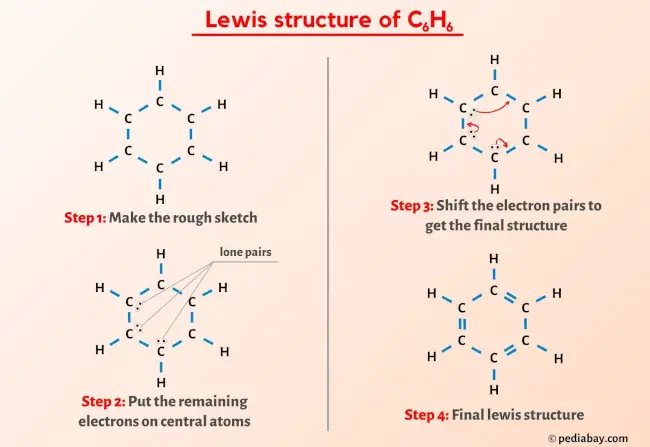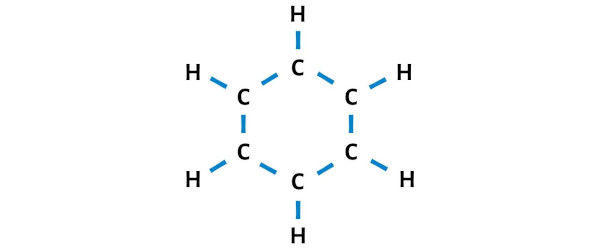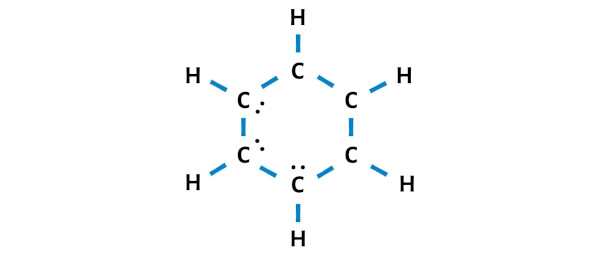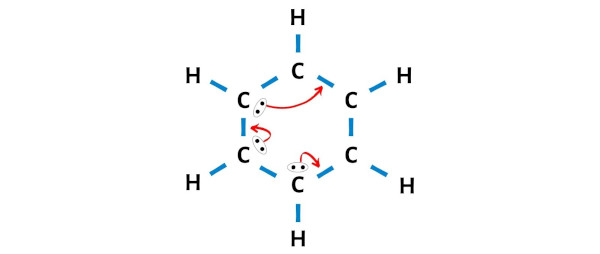
So you have seen the above image by now, right?
Let me explain the above image in short.
C6H6 (Benzene) lewis structure has 6 carbon atoms (C) in a ring-like structure and each carbon atom has 1 Hydrogen atom (H) attached to it. There are alternating double bonds in the ring structure of Carbon (C).
If you haven’t understood anything from the above image of C6H6 lewis structure, then just stick with me and you will get the detailed step by step explanation on drawing a lewis structure of C6H6.
So let’s move to the steps of drawing the lewis structure of C6H6 (benzene).
Steps of drawing C6H6 lewis structure
Step 1: Find the total valence electrons in C6H6 molecule
In order to find the total valence electrons in a C6H6 molecule, first of all you should know the valence electrons present in carbon atom as well as hydrogen atom.
(Valence electrons are the electrons that are present in the outermost orbit of any atom.)
Here, I’ll tell you how you can easily find the valence electrons of carbon as well as hydrogen using a periodic table.
Total valence electrons in C6H6 molecule
→ Valence electrons given by carbon atom:

Carbon is group 14 element on the periodic table. [1] Hence the valence electrons present in carbon is 4.

You can see the 4 valence electrons present in the carbon atom as shown in the above image.
→ Valence electrons given by hydrogen atom:

Hydrogen is group 1 element on the periodic table. [2] Hence the valence electron present in hydrogen is 1.

You can see that only 1 valence electron is present in the hydrogen atom as shown in the above image.
Hence,
Total valence electrons in C6H6 molecule = valence electrons given by 6 carbon atom + valence electrons given by 6 hydrogen atoms = 4(6) + 1(6) = 30.
Step 2: Prepare the rough sketch
Lewis structure of benzene (C6H6) has 6 carbon atoms which are arranged in a ring-like structure.
Also each of these carbon atoms has 1 hydrogen atom attached to it.
So let’s draw the sketch which represents the ring of 6 carbon atoms and hydrogen atoms attached to each carbon.

There are 12 single bonds in the above sketch. So out of the total 30 valence electrons, 24 valence electrons are used in the above sketch.
Step 3: Keep the remaining electrons on the central atom
You can see that in step 1 we have calculated the total number of valence electrons present in the C6H6 molecule.
The C6H6 molecule has a total of 30 valence electrons and out of these, only 24 valence electrons are used in the above sketch.
So the number of electrons which are left = 30 – 24 = 6.
You have to put these 6 electrons (i.e 3 electron pairs) on the carbon atoms in the above sketch of C6H6 molecule.

Now let’s proceed to the next step.
Step 4: Make all the atoms stable
From the above sketch, you can see that the outer hydrogen atoms are forming a duplet. Hence they are stable.
Now out of the 6 carbon atoms, the three carbon atoms are not forming an octet.
So we have to shift the electron pairs in such a way that all the carbon forms an octet and becomes stable.

After shifting the electron pairs, you can see that all the 6 carbon atoms form an octet and they are now stable.

Hence this is the stable lewis structure of benzene (or C6H6).
I hope you have completely understood all the above steps.
For more practice and better understanding, you can try other lewis structures listed below.
Try (or atleast See) these lewis structures for better understanding:
| NBr3 Lewis Structure | SeF4 Lewis Structure |
| H3PO4 Lewis Structure | H2Se Lewis Structure |
| SOCl2 Lewis Structure | ICl2- Lewis Structure |
Jay is an educator and has helped more than 100,000 students in their studies by providing simple and easy explanations on different science-related topics. He is a founder of Pediabay and is passionate about helping students through his easily digestible explanations.
Read more about our Editorial process.

